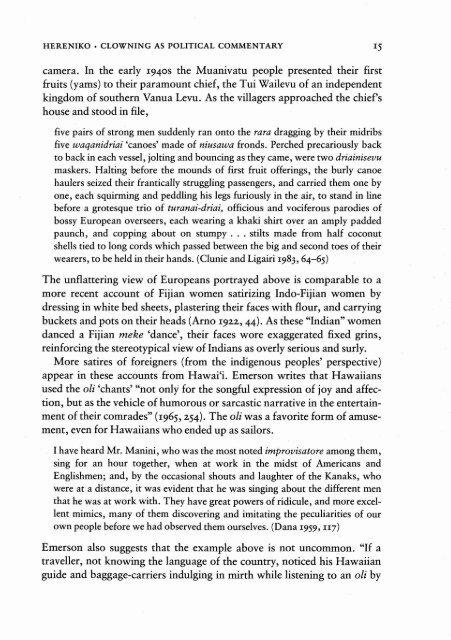Clowning as Political Commentary: Polynesia, Then ... - ScholarSpace
Clowning as Political Commentary: Polynesia, Then ... - ScholarSpace
Clowning as Political Commentary: Polynesia, Then ... - ScholarSpace
Create successful ePaper yourself
Turn your PDF publications into a flip-book with our unique Google optimized e-Paper software.
HERENIKO • CLOWNING AS POLITICAL COMMENTARY<br />
camera. In the early 1940S the Muanivatu people presented their first<br />
fruits (yams) to their paramount chief, the Tui Wailevu of an independent<br />
kingdom of southern Vanua Levu. As the villagers approached the chief's<br />
house and stood in file,<br />
five pairs of strong men suddenly ran onto the rara dragging by their midribs<br />
five waqanidriai 'canoes' made of niusawa fronds. Perched precariously back<br />
to back in each vessel, jolting and bouncing <strong>as</strong> they came, were two driainisevu<br />
m<strong>as</strong>kers. Halting before the mounds of first fruit offerings, the burly canoe<br />
haulers seized their frantically struggling p<strong>as</strong>sengers, and carried them one by<br />
one, each squirming and peddling his legs furiously in the air, to stand in line<br />
before a grotesque trio of turanai-driai, officious and vociferous parodies of<br />
bossy European overseers, each wearing a khaki shirt over an amply padded<br />
paunch, and copping about on stumpy ... stilts made from half coconut<br />
shells tied to long cords which p<strong>as</strong>sed between the big and second toes of their<br />
wearers, to be held in their hands. (Clunie and Ligairi 1983, 64-65)<br />
The unflattering view of Europeans portrayed above is comparable to a<br />
more recent account of Fijian women satirizing Indo-Fijian women by<br />
dressing in white bed sheets, pl<strong>as</strong>tering their faces with flour, and carrying<br />
buckets and pots on their heads (Arno 1922, 44). As these "Indian" women<br />
danced a Fijian meke 'dance', their faces wore exaggerated fixed grins,<br />
reinforcing the stereotypical view of Indians <strong>as</strong> overly serious and surly.<br />
More satires of foreigners (from the indigenous peoples' perspective)<br />
appear in these accounts from Hawai'i. Emerson writes that Hawaiians<br />
used the oli 'chants' "not only for the songful expression of joy and affection,<br />
but <strong>as</strong> the vehicle of humorous or sarc<strong>as</strong>tic narrative in the entertainment<br />
of their comrades" (1965, 254). The oli w<strong>as</strong> a favorite form of amusement,<br />
even for Hawaiians who ended up <strong>as</strong> sailors.<br />
I have heard Mr. Manini, who w<strong>as</strong> the most noted improvisatore among them,<br />
sing for an hour together, when at work in the midst of Americans and<br />
Englishmen; and, by the occ<strong>as</strong>ional shouts and laughter of the Kanaks, who<br />
were at a distance, it w<strong>as</strong> evident that he w<strong>as</strong> singing about the different men<br />
that he w<strong>as</strong> at work with. They have great powers of ridicule, and more excellent<br />
mimics, many of them discovering and imitating the peculiarities of our<br />
own people before we had observed them ourselves. (Dana 1959, II?)<br />
Emerson also suggests that the example above is not uncommon. "If a<br />
traveller, not knowing the language of the country, noticed his Hawaiian<br />
guide and baggage-carriers indulging in mirth while listening to an oli by
















